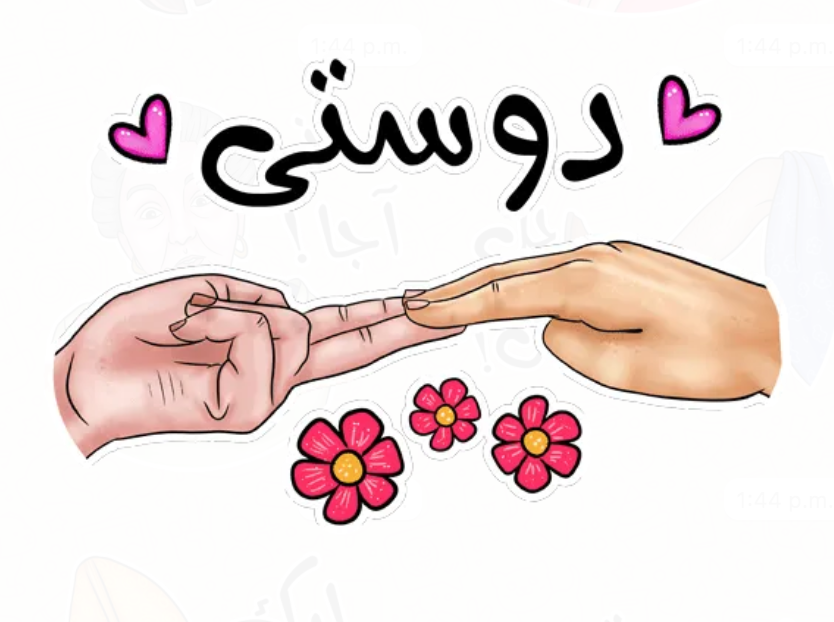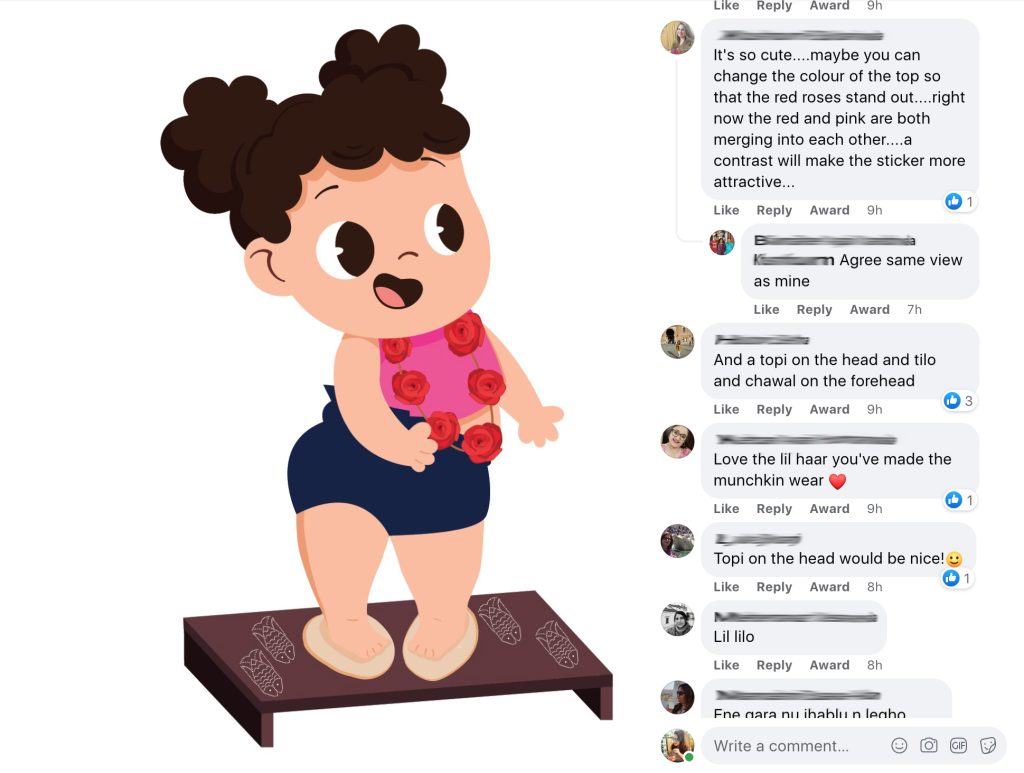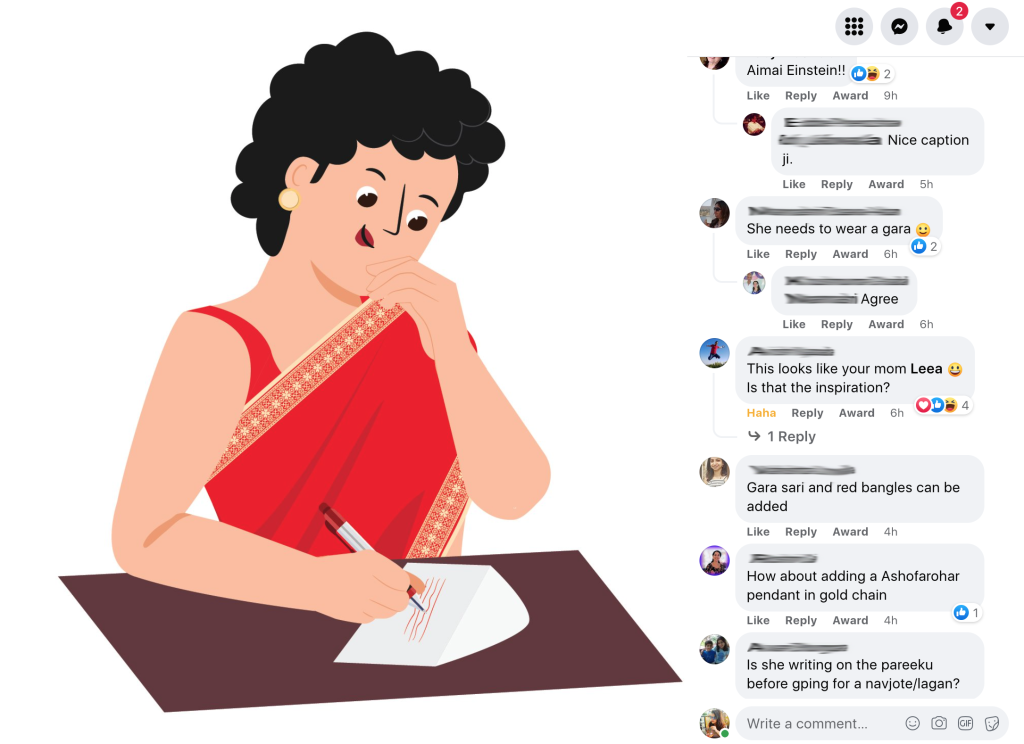GSMD-500 | Grad Studio 2
Prompt 6: The Sticker life continues
For this prompt, I continued to build on my sticker pack, with more rituals and symbolic items. I intend to share this sticker pack with my fellow Zoroastrians to gain some input and insight as well as to note the reactions they may have to finally have stickers that they can relate to and use when sending virtual greetings.
1.1 – The nagging question:
Each ritual has very specific tasks that need to be done and objects that need to be collected and placed in a certain way. Unfortunately, as most of these rituals and traditions have been passed down orally from one generation to the next, there is no specific place, online or in a book, with its documentation. A question that keeps popping up is: What will we do as the next Parsi generation, when our elders are no longer there?
1.2 – Recruiting Anita:
Luckily, the one person, most Parsis back home in Karachi go-to for all these details is my mother. She has handwritten most of these rituals in a book, which she keeps handy, and shares with most of my community. I requested her to read through them and keep them in my visual bank for future projects.
2 – The Visual Research continues:
3.1 – Creating the sticker:
Chitti Lakhvanu
The Chitti Lakhvanu is one of the rituals that take place before the wedding ceremony. For this ritual, the Bride/Grooms family come together to handwrite their guests’ names on their wedding invitations. The first name written is typically the name of a family elder, and is seen as the most important one.

When designing this sticker, I wanted to create a visual that can represent the ritual in a minimalist way, and so I started off by designing an envelope with an invitation.
I used the colour red for the text on the invitation as that is seen as an auspicious colour in our community and is typically used in such situations.

I then decided to push this concept further, as it did not really show the true essence of the ritual i.e the names being written on the envelope, and so I designed another sticker with a lady doing so.
I was happy with the results, but there was something missing. I was not able to connect this visual with the ritual I have seen happen numerous times before.
After thinking about this for a few days, I realized my mistake. The lady I designed looked nothing like the ladies I have seen doing this ritual. Typically, it will be an older lady (the mother of the bride) who is wearing our traditional clothes, a sari (usually a red one) with a Kore (these are borders that are used to embellish a sari).

And so I created this sticker.
Her name is Jeroo.
3.2 – The rest of the pack:
Cake and Wine

Another ritual that is part of the wedding celebrations is the cake and wine. After the wedding celebration is over, bridal parties close family and friends stay on for the second part of the celebration, where the bride and groom cut their wedding cake, pop a bottle of champagne and speeches are made.
Dahi Machli Ni Ses

This ritual is part of the Adravvanu (engagement) celebration where both families have a group of 5-7 ladies from their household go to one another’s house and exchange clothes for the bride and groom.
Each group of ladies carry with them a special Ses, called the dahi machli ni ses, which includes curd, fish (fresh fish or sweetmeat/chocolate in the shape of a fish) and sakar.
After both families do so, they meet at the brides’ house and the boy and girl exchange engagement rings.
Jashan
A Jashan is seen as a service of blessing and thanksgiving. A white cloth, sofreh, is spread on a table or on the floor and is laid out with seven kinds of fruits, a tray containing seven kinds of dried fruits (lurk), a metal cup with milk and another with water, a vase of flowers and a vase containing sprigs of the evergreen cypress (sarv) tree. A fire is kept burning in a metal fire vase, and the wood to serve the fire during the ceremony is also kept in the tray.

Priests exchange flowers over the fire during the Jashan ritual. In a traditional three-part Jashan, the priests exchange flowers twice during each segment, karda of the Jashan. The first flower is symbolic of the spirit of Ahura Mazda. The second set of six flowers, which are handed over to the assistant priest, represents the remaining six Bounteous Immortals.
Navjote
Spiritual purity in Zoroastrianism is brought about through the performance of the padyab-i kusti which is the ritual of untying and retying the sacred cord (kusti) which every Zoroastrian from about the age of seven is expected to wear. The sacred cord circumscribes the waist three times and is worn over an undershirt known as the sudreh.

The sudreh and kusti are given to the child after a ritual initiation known as the navjote. This important ceremony welcomes the child into the faith and is performed by a person who has been inducted, formally, into the Zoroastrian priesthood, which is hereditary.
Topi

A velvet or cotton cap that covers all the hair. It is worn during all religious rituals, when going into the Agyari, during the navjote and during any type of prayers.
Dastoorji/Mobed

A Mobed (priest), wearing the traditional Padan (mouth-veil), which is typically worn when they are praying in front of the fire, to prevent his breath from reaching it.
Chalk Stamps

Parsis use perforated lightweight metal chalk boxes into which white chalk powder is put and stamped on the damp floor. A dash of red, orange, pink, green and yellow chalk colours are added to enhance the patterns. The designs are mostly floral with symbols of good luck; fish and horseshoe. Quotes in English and Gujarati such as “Good Luck” are also common. Typically the chalk stamps are used for auspicious occasions such as birthdays, weddings and Navjotes.
4.1 – Parsi’s Reactions:
The reactions/suggestions/comments/feedback that I have received was extremely helpful! I was so happy to see the reaction my community had and how they engaged with the stickers.
The fact that so many Zoroastrians responded to this so quickly showed me the need for these stickers and the use they would have in connecting my community and representing them on social media platforms.
My post was also shared on another Facebook Page “Karachi Parsis”
4.2 – Feeback on Individual images





















